This post contains affiliate links. Please see our disclosure policy.
Discover effective stretching exercises for plantar fasciitis relief! Learn gentle, targeted stretches to reduce heel pain, improve flexibility, and support recovery, helping you stay active and pain-free.
Plantar fasciitis can be a painful roadblock in daily life, especially for those who love staying active. But the good news is, stretching can be a powerful tool for relief!
The stretches below will help loosen tight muscles, increase flexibility, and support your recovery journey.
Whether you’re dealing with occasional flare-ups or chronic discomfort, adding these exercises to your routine can make a big difference!
Regular and consistent stretching is going to be key for any plantar fasciitis treatment plan. It is best to do each exercise not only daily but in some cases several times a day.
The good news is they can be spread out throughout the day. Here’s a sample of how to easily work them into your daily routine.
Make sure you do these for BOTH of your feet, even if you only have pain on one side.

Save This Article To Read Later
Plantar Fasciitis Stretches for Before You Get Out Of Bed
These plantar fasciitis focused stretches are best to do before you even get out of bed! Add these into your morning wake up routine for better relief!
Hand Stretch & Massage
Before you get out of bed, use your hands to gently pull the top of your foot back stretching it very lightly. Then take your thumbs and, starting in the middle of your foot pull each thumb toward the outer edges of the foot almost like you are trying to get rid of a wrinkle.
Do this in 3 or 4 different places at the bottom of your foot.
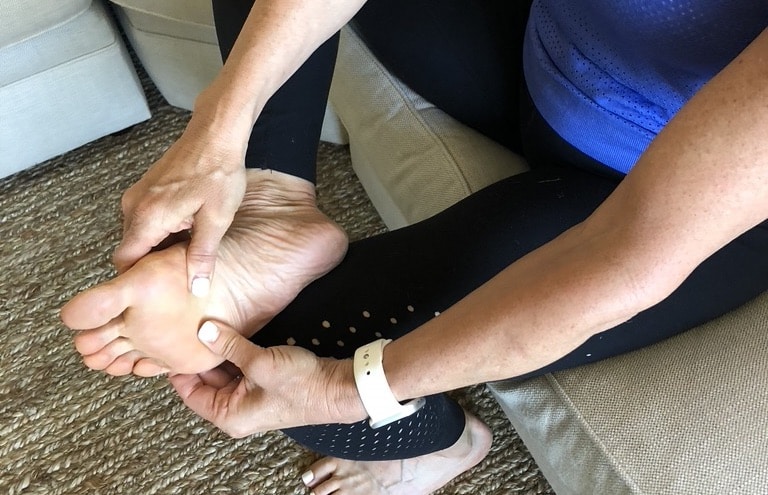
Alphabet Game
Next, sit up in bed and hang your legs over the side to play the alphabet game with your foot. Point your big toe and draw the alphabet from A to Z with each foot to strengthen and stretch the foot and calf.
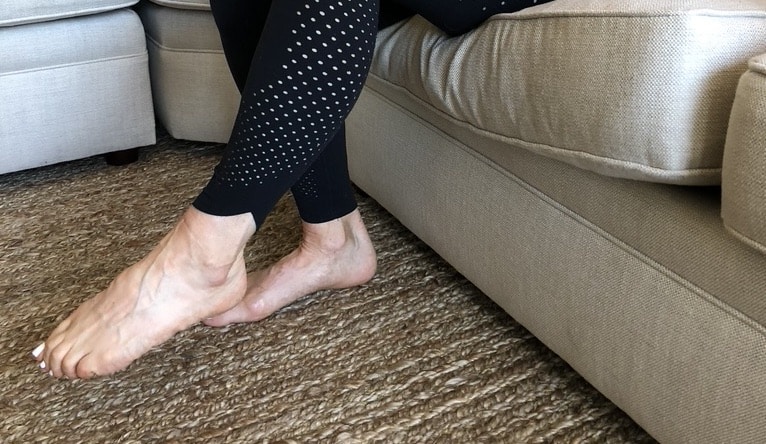
Roll It Out
After the alphabet game, slowly stand up and place one foot on a massage ball, tennis ball, or frozen water bottle and slowly roll it across the bottom of the foot starting at the heel. Once you reach your toes go back slowly in the other direction.
Repeat 3 times for each foot.
Choosing a frozen water bottle gives you the bonus of reducing inflammation while the rolling massage helps you get prepared to step and move.
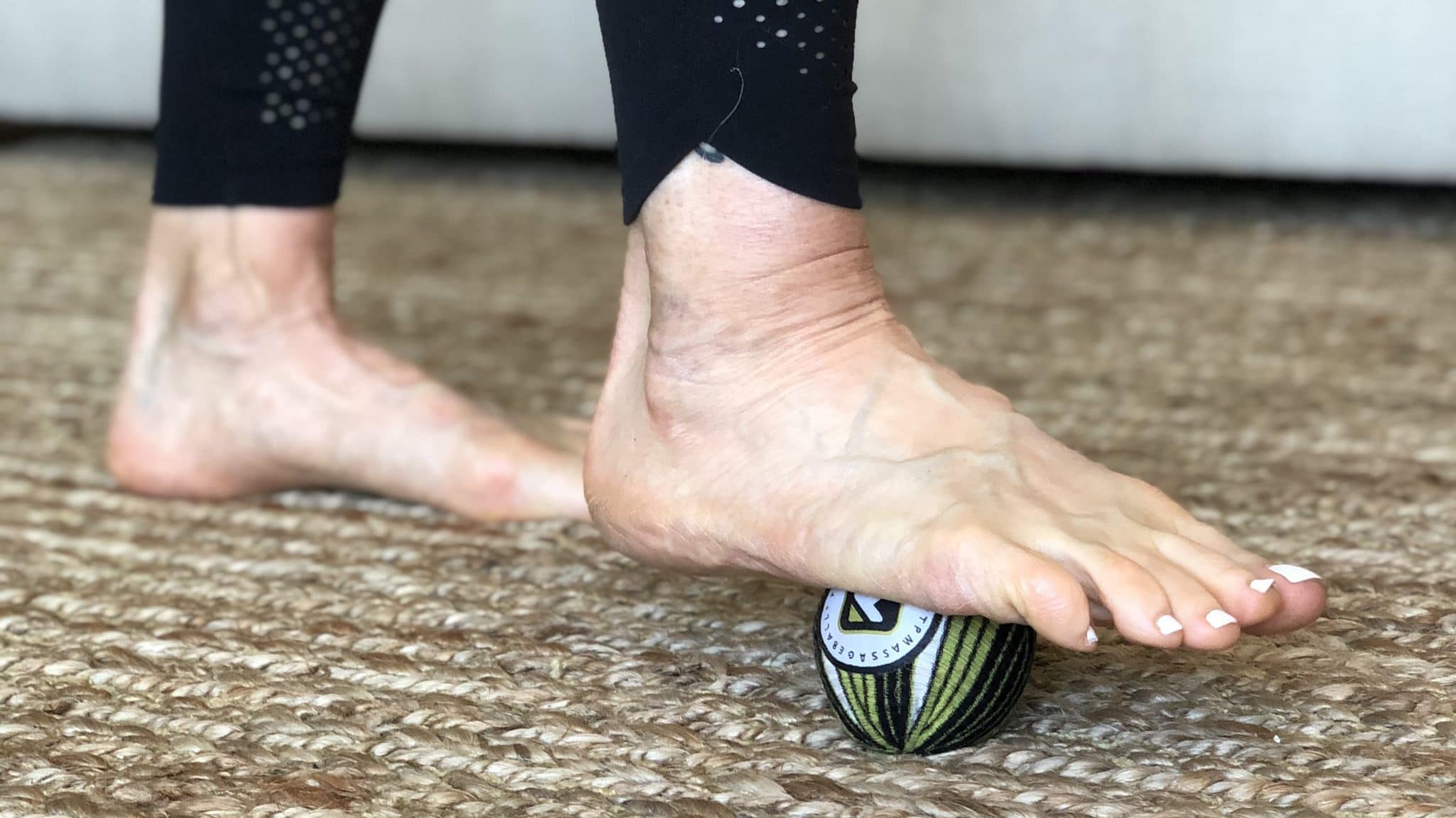
Plantar Fasciitis Stretches for Before or After Lunch
Incorporate these stretches for plantar fasciitis either before or after your lunch. They are perfect for the midday break.
Step Stretch
Find the nearest set of stairs and stand on the bottom step. Put the ball of the foot you want to stretch on the step and let the heel drop down for 30 seconds.
Switch to the other foot and do the same. Stretch each foot 3 times.
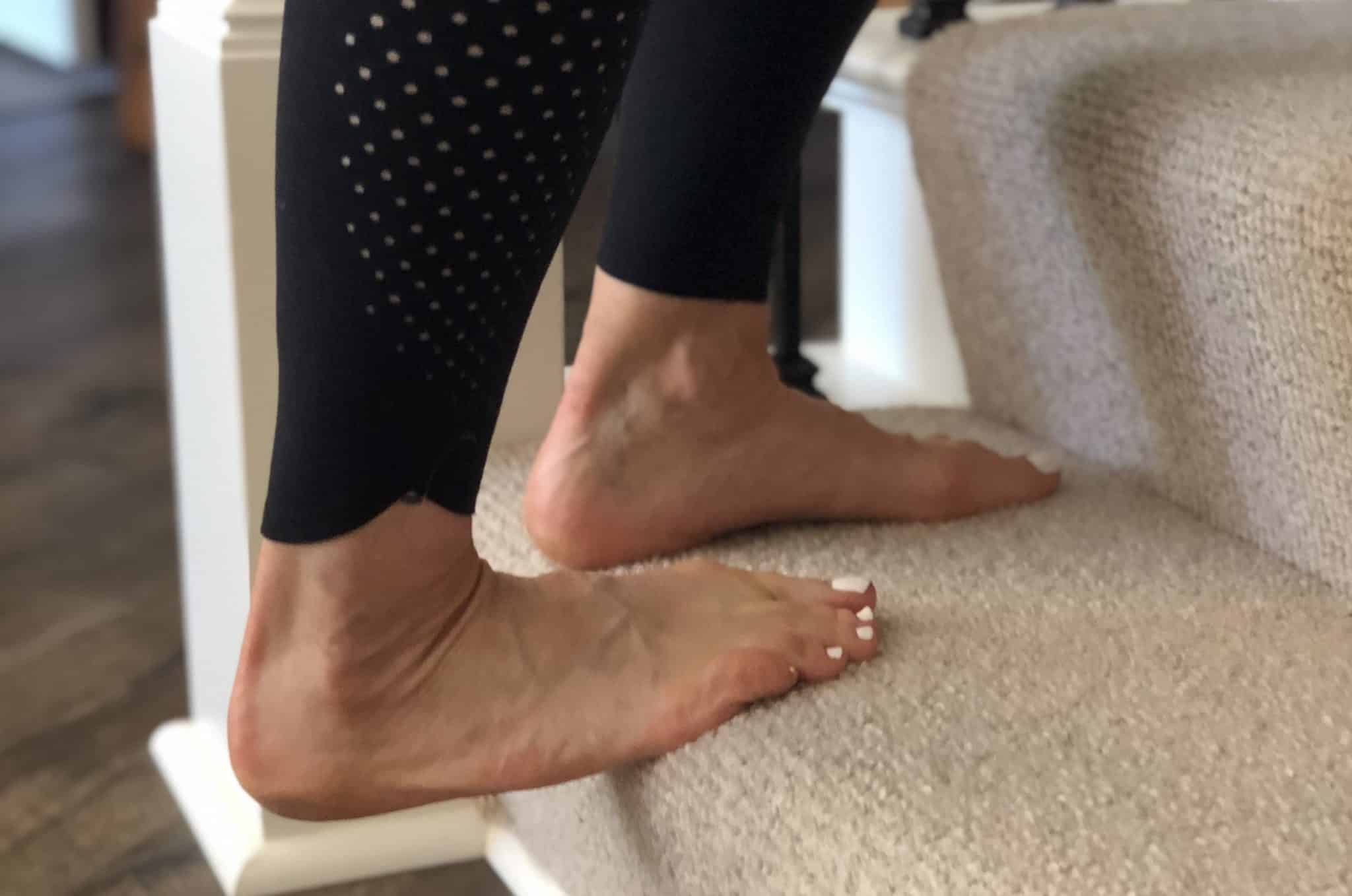
Heel Press
Stand facing a wall and place both hands against the wall. Step one foot back and press the heel of that foot firmly into the ground keeping your leg straight.
Move your hips forward until you feel a stretch in your calf.
Hold 30 seconds. Switch legs and repeat.
Try 3 times per foot. Don’t bounce! Remember that tight calves are often the origin of heel pain.
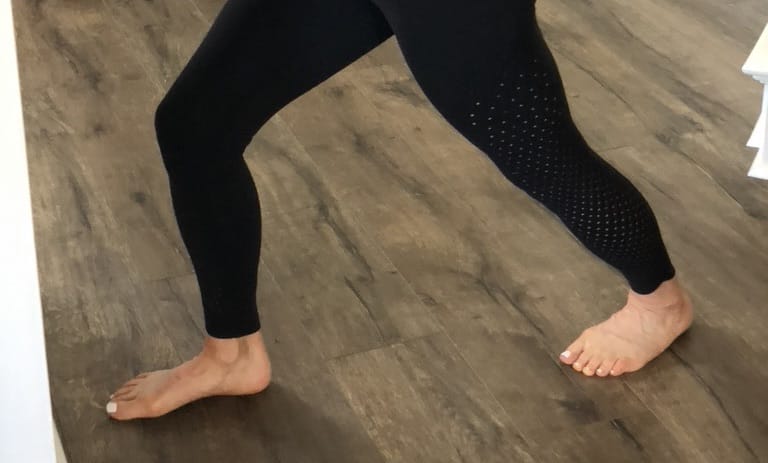
Plantar Fasciitis Stretches for Just Before Bed
Add these plantar fasciitis stretches to your bedtime to routine to finish of you day of exercises!
Washcloth Exercise
Sit on a chair or the edge of your bed with a washcloth on the floor. Keep your heel on the ground and lift the washcloth with your toes.
Release and repeat 10 times. Repeat on the other foot.
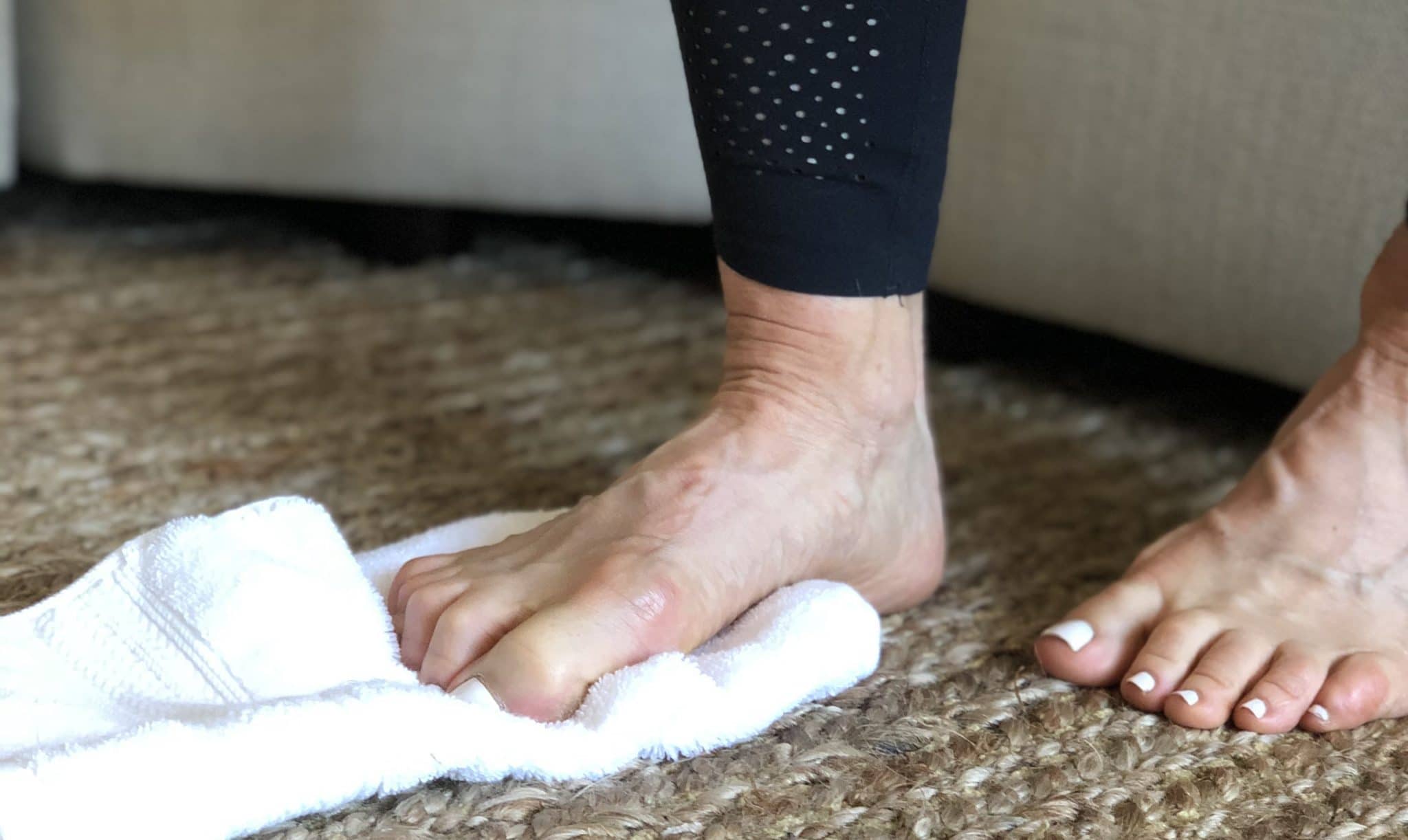
Seated Straight Leg Stretch
Grab a long band and or towel and sit down on the floor with your legs straight out in front of you. Place the band or towel around one foot, keeping that leg straight.
Gently pull back on the band or towel holding for 30 seconds and breathing gently.
Switch to the other floor. Stretch each side 3 times.
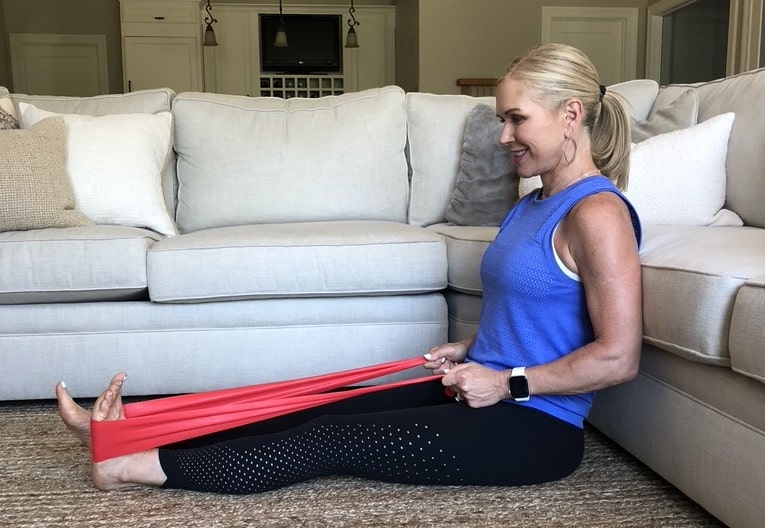
Additional Plantar Fasciitis Treatments
In addition to performing the above stretches for plantar fasciitis, you may want to add on some additional treatments.
When plantar fasciitis is treated early, most people resolve their pain with conservative treatments within six weeks. However, sometimes it takes a few treatments stacked on top of one another.
Here are some tried and true treatment options that can be utilized to relieve plantar fasciitis pain:
Ice
Just like with other injuries, the inflammation of plantar fasciitis can be helped with ice. The best way to do this is to use a frozen water bottle and roll it back and forth under your foot for about 10 minutes, several times a day. Do it at meals, under your desk while you work, or even at night when you watch TV. Be consistent.
Massage
No, you don’t have to pay for it. While you are sitting, roll a tennis ball around under your foot to massage the area. It works like a foam roller for your foot. Of course, the frozen water bottle also serves this purpose.
Medication
Over-the-counter anti-inflammatories can help. Ibuprofen or Naproxin are good bets to reduce inflammation and provide pain relief.
Rest
Your feet need time off from whatever is causing the issue. Stop or cut way back on high-impact exercises.
New Shoes
What a great prescription, huh? Most people wear their workout shoes for far too long before replacing them.
Remember that the plantar fascia muscle, which runs along the bottom of your foot, helps support the arch of your foot. So it makes sense that if you do not wear shoes with proper support you are putting extra wear and tear on that fascia. This leads to the muscle being strained and small tears can be created.
Also, many find relief by wearing supportive shoes or shoe inserts (more on that below) very regularly. Keeping shoes on as much as possible allows the fascia to heal more quickly and maintain support.
Check out my guide for what really matters in a walking shoe to get my expert tips!
Night Splits or Night Boot
Night splints (or a night boot) help relieve plantar fasciitis pain and was the most important thing I did to heal my plantar fasciitis many years ago. A night splint looks similar to a boot or sock.
You put it on your foot before you go to sleep, and the device lifts your toes and holds your foot in a gentle stretch all night long. By holding it in this flexed position, the tendon has a chance to heal.
Shoe Inserts For Plantar Fasciitis
Cheap or improper shoes can be one of the causes of plantar fasciitis, but before you go buying brand new shoes, you may also consider shoe inserts. Inserts last longer and can be moved from shoe to shoe as needed.
Here are some things to keep in mind when looking for shoe inserts:
- Look for insoles that have been well-tested and recommended by other users. If you don’t know someone personally, read the reviews online.
- Take time to know your own feet before you buy. Neutral? Pronator? Supinator? Get a diagnosis from a medical professional or a specialized running store that uses a treadmill to watch you and help you understand your gait.
- Look for inserts with deep heel cups. Generally, those who experience plantar fasciitis need more support in the arches of the feet. A deeper heel cup will provide this. Do you have flat feet? Low Arches? Moderate arches? If you aren’t sure, Runner’s World provides you with the Wet Feet Test that you can do at home to determine the amount of arch support you will need.
- Give the inserts time to break-in. Just like a new pair of shoes, the inserts will change the foot movement and your feet will need time to adjust. Do it in small doses.
Here are a few of our favorite options to help you get started:
- Airplus Plantar Fasciitis Orthotic
- Superfeet Black Premium Insoles
- Powerstep Protech Orthotic Supports
- Powerstep Unisex Pinnacle Maxx Insole
- GEL Orthotic Shoe Gel Insoles
Working Out with Plantar Fasciitis
So, is it okay to work out with plantar fasciitis? Yes!
Exercising with plantar fasciitis is, in general, something you can do. Just be aware that you may have to adjust your workouts until the problem is resolved and even then, make sure you resume your regular activities slowly.
There are two things to remember when you decide to work out with plantar fasciitis.
- It is critically important to wear proper, supportive shoes at all times! Even if you participate in water aerobics, there are shoes for you and you need to have them on!
- Participate only in things that will not contribute to the heel strike or pounding of your feet. Here are some suggestions.
Workouts To Try With Plantar Fasciitis:
These workouts are typically low impact: meaning they reduce the amount of impact that your foot will have to absorb.
- Swimming
- Water Aerobics
- Elliptical Machine
- Weight Lifting
- Cycling with hard surface shoes
- Rowing Machine
- Yoga
- Mat Pilates
Workouts To Avoid With Plantar Fasciitis
These workouts are typically high impact: meaning the amount of impact your foot will have to absorb is not recommended when dealing with plantar fasciitis.
- Running
- Jumping
- Bouncing
- Step Aerobics
- Walking for fitness
- Going barefoot or wearing flip-flops (use shoes even in your home!)
More About Plantar Fasciitis
Plantar fasciitis (“plan-tur-fash-ee-eye-tis”) is a common foot injury and a fairly easy one to fix if you act early.
The plantar fascia is a thick band of connective tissue that runs along the bottom of your foot connecting your heel to the base of your toes. It acts like a shock absorber supporting the arch in your foot.

If tension on the fascia is overloaded, tiny tears are produced resulting in irritation, inflammation and pain. The pain might feel like a stabbing sensation in the heel or arch of the foot, or it might feel more like deep aching or throbbing.
Most people feel this pain when getting out of bed in the morning. The pain generally subsides as the foot gets warmed up and moving.
This is because the fascia is contracted at night almost as if it tries to heal itself. When you step on it getting out of bed, a sudden strain occurs all over again.
If you have plantar fasciitis, you may be looking for exercises and stretches for relief and to help heal. And the sooner you start to treat plantar fasciitis the better since the longer you wait, the worse it typically gets and the longer it will take to heal.



Had anyone tried PRP injections for it? Or other treatments besides Tenex? Are they painful?
I did get the injection on the inner part of my heel. felt the pressure, but afterwards it was fine. had the boot on for 2 weeks now. I don’t even feel the pain in the mornings anymore. dr told me no cardio, but I cant just sit around and get fat. im starting the elliptical back today and the rower. I have also been lifting weights since the boot just to do something that the gym.
I did the PRP injection 2 months ago. I weigh 298 lbs. I thought I’d die the first 3 days, then the pain eased up. Used a seated walker (no room for wheelchair in home, and unable to use a knee scooter or crutches) and stayed 100% off foot for 2 weeks. Then able to gradually stand, etc. for short periods (told to use motorized scooter provided by stores when shopping). Now, 2 months later I am pain-free for first time in years. Best money I’d ever spent (not covered by insurance). BUT be sure to follow 100% of doctor’s orders and don’t rush the healing process!
I tried the shots once and thot id die.. the pain was so bad for5days..and honestly it didnt work..but ive had friends tell me try again.. but im way to scared of those giant shots..but il admit im thinking of it now..30pounds later and working out everyday to zero days😔
I have had p f for 3 years now. I was very active 6 days a week to 0. A month ago my doc put me in a fracture boot and its working. I took steroids for 15 days to get the swelling down and got a mri. The mri showed a cyst right where the PF is. OMG this might need to be taken out now.. He wasn’t me to keep the boot on for another 3 weeks but thinking that it’s going to be fine now. The boot is helping like 95% I’m still waiting to see if it is possible for this to work. Good luck
I had severe plantar fasciitis for years from an injury from running too much without warming up. The pain continued for years. I wrapped my feet, and used ice packs. Nothing. Finally visited a podiatrist who made hard orthotics from a plaster mold of my feet. These were made from some type of polymer, they will never wear out. The minute I put them in my shoes my feet stopped hurting. The pain had been so bad that I had to walk on my tiptoes. Twenty five years later, I still wear these orthotics and am still pain free.
I had bone spurs along with PF. Orthotics worked great until my PF tissue had scarred soooo much it wouldn’t stretch anymore. I had surgery and it cured it. They cut a tinyclit on each side of my heel, then cut the tissue 3/4 of the with across allowing it to stretch. Walking cast boot for 2 weeks. Didn’t need orthotics anymore, but still wear shoes with good arches. Avia is a good walking shoe. It took a good year to heal & now I can go bare foot as well. Eventually had other one done & life is much better!! 😀👣
I’ve suffered from PF for almost 7 years now. I’ve seen 3 Podiatrists and none have come up with anything that helps me. In fact, they all have the same playbook and none of their suggestions helped. I have done ice: doesn’t do anything but make my foot cold; I’ve done PT and it made my pain worse; I’ve done all the stretching exercises: has not relieved any pain; I’ve spent thousands of dollars on inserts and shoes and none have relieved my pain: makes pain worse; I currently wear a night splint: makes my foot go numb and I can’t sleep; I’ve taken the anti-inflammatory meds with no effect: even used anti-inflammatory topical that did nothing. Each Podiatrist has basically kicked me out of their office because their playbook didn’t work for me. I now have additional health problems because of this. I have knee pain, difficulty walking through the grocery store, can’t do anything that involves using my feet for more than 15 minutes so I have gained 70lbs. My blood pressure is rising because I can’t work out anymore. No one will help me. No one will leave that playbook alone and actually help me. And now depression has set in. So kudos to the medical field for their epic fail.
I had PF for 2.5 years and tried pretty much everything other than surgery. My podiatrist finally said I had to get off the foot. I wore a boot and used a knee scooter for several months and it finally went away. Unfortunately, it just came back about 2 days ago, but in my other foot. It was a hassle staying off of it as I am a teacher and I work 2 jobs, but it did finally get rid of it.
Hey! here is a link for chronic situations, these are extensive ways and found most effective for chronic situations. Hope this helps! https://m.youtube.com/watch?v=BeILXt3oLEo
I have had PT for 6 months- there is a guy on You Tube William Prowse IV who had PT in his early 20s from gymnastics. He knows so much about PT. It might be worth watching his videos. I also got his book ( ebook Pantar Faciitis survival guide), for about £5 and it goes through a programme to help get rid of PT. I have just started the programme
I feel your pain..im on 11years..im a trainer active great weight..now down to 0workouts&30 pounds..im waitng to see my foot dr soon as i can get in..the pain is so bad..id take the operation if i get offered it.. but a friend of mine just told me last night its a50/50 chance it works..i dont know if thats true but..i cant take this pain.its rediculous..i NEED TO WORKOUT..not lay in this bed anymore its terrible..
I had pf gor 4 years had physio .. sports podiatrists orthotics etc I had it in both feet … what fixed it … 2 sessions of Bowen therapy . The first one created such an inflamitary response was wondering what I had done .. the second one a couple of weeks later fixed it permanently I carried non running after that and have had nil issues for 9 years .. I decided to add some foam rolling into my running following a professional programme … which has created inflammation in my calves and plantar which has not gone away … heading back to Bowen therapy I know it works
I am 54.I have had PF for a year and a half and it is really awful. I went from 7 or 8 Aquafit sessions a week to 0. Cannot even walk around the loch. 20 minutes and my feet are done in especially the right though it stared on the left. I received laser treatment on the nhs which did help the left one to some extent but as I say the right one is sore. I have put on abut 3 stone and I am just fed up with it. I feel really old and frumpy because I have to wear trainers like Sketchers all the time and I cannot contemplate going anywhere on holiday where a lot of walking is involved. I feel I am just one of those older women you see with bad feet and wonder why sob sob. Self pity mode has kicked in lol.
I feel really sorry for anyone who has had this long term. My has just started, my favourite exercise is aquafit, three per week plus several hours of tennis. I thought I had bruised my right foot/heel but now I know what’s wrong. My own fault in a way, I stopped wearing aqua shoes as they caused drag and made some exercises difficult, big mistake, also I’ve worn flip flops at home and we have stone floors.
I’m hoping a holiday with no aqua will ease what has happened but I’m going to ensure I wear my aqua shoes at all times from now on.